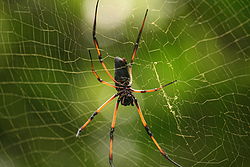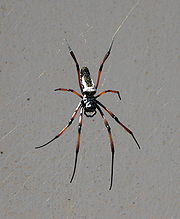
Nephila inaurata
Encyclopedia
The red-legged golden orb-web spider (Nephila inaurata) is a species of golden orb-web spider. It lives in Southern Africa and several islands in the Indian Ocean
(Madagascar
, the Seychelles
, Réunion
, Mauritius
, Rodrigues
). Like other spiders in the family Nephilidae
it can weave webs so strong that sometimes even birds and bats get caught. Its webs can be found in damp places such as large trees and unpolluted areas to which no cars have access; normally several are strung together to form enormous "homes" so as to cover as much surface area as possible.
This species feeds on flies, mosquitoes, moths, wasps and unfortunate beetles who happen to get tangled up.
In addition to the nominate (Nephila i. inaurata), a second subspecies
is currently recognized: Nephila inaurata madagascariensis (Vinson, 1863), which occurs from South Africa
to the Seychelles
.

 This species is commonly kept in captivity. Egg sacks the size of a small marble are made of thick silk and contain 100-200 eggs which hatch after two months. They start out with a 2mm legspan and grow rapidly. Males mature in one to two months depending on the form. A small percentage of males mature early and resemble a small, black crab spider with only an 8-10mm legspan. Most males mature later and resemble the form of the female but have very little color and only a 25-30mm legspan. Mature males are rarely, if ever, observed feeding. Females mature in four months with an approximate 100mm legspan. [Source "Golden Silk Spiders", Invertebrate-Magazine Vol.4, Issue 2 March 2005]
This species is commonly kept in captivity. Egg sacks the size of a small marble are made of thick silk and contain 100-200 eggs which hatch after two months. They start out with a 2mm legspan and grow rapidly. Males mature in one to two months depending on the form. A small percentage of males mature early and resemble a small, black crab spider with only an 8-10mm legspan. Most males mature later and resemble the form of the female but have very little color and only a 25-30mm legspan. Mature males are rarely, if ever, observed feeding. Females mature in four months with an approximate 100mm legspan. [Source "Golden Silk Spiders", Invertebrate-Magazine Vol.4, Issue 2 March 2005]
An example of a tapestry woven entirely from the madagascariensis subspecies' silk can be seen at this link: http://www.npr.org/templates/story/story.php?storyId=113223398
Indian Ocean
The Indian Ocean is the third largest of the world's oceanic divisions, covering approximately 20% of the water on the Earth's surface. It is bounded on the north by the Indian Subcontinent and Arabian Peninsula ; on the west by eastern Africa; on the east by Indochina, the Sunda Islands, and...
(Madagascar
Madagascar
The Republic of Madagascar is an island country located in the Indian Ocean off the southeastern coast of Africa...
, the Seychelles
Seychelles
Seychelles , officially the Republic of Seychelles , is an island country spanning an archipelago of 115 islands in the Indian Ocean, some east of mainland Africa, northeast of the island of Madagascar....
, Réunion
Réunion
Réunion is a French island with a population of about 800,000 located in the Indian Ocean, east of Madagascar, about south west of Mauritius, the nearest island.Administratively, Réunion is one of the overseas departments of France...
, Mauritius
Mauritius
Mauritius , officially the Republic of Mauritius is an island nation off the southeast coast of the African continent in the southwest Indian Ocean, about east of Madagascar...
, Rodrigues
Rodrigues
Rodrigues is a common surname in the Portuguese language. It was originally a Patronymic, meaning Son of Rodrigo or Son of Rui. The "es" signifies "son of". The name Rodrigo is the Portuguese form of Roderick, meaning "famous power" or "famous ruler", from the Germanic elements "hrod" and "ric" ,...
). Like other spiders in the family Nephilidae
Nephilidae
The Nephilidae are a spider family with 75 described species in four genera. They were formerly grouped in the families Araneidae and Tetragnathidae. The genus Singafrotypa was moved to Araneidae in 2002.All nephilid genera partially renew their webs....
it can weave webs so strong that sometimes even birds and bats get caught. Its webs can be found in damp places such as large trees and unpolluted areas to which no cars have access; normally several are strung together to form enormous "homes" so as to cover as much surface area as possible.
This species feeds on flies, mosquitoes, moths, wasps and unfortunate beetles who happen to get tangled up.
In addition to the nominate (Nephila i. inaurata), a second subspecies
Subspecies
Subspecies in biological classification, is either a taxonomic rank subordinate to species, ora taxonomic unit in that rank . A subspecies cannot be recognized in isolation: a species will either be recognized as having no subspecies at all or two or more, never just one...
is currently recognized: Nephila inaurata madagascariensis (Vinson, 1863), which occurs from South Africa
South Africa
The Republic of South Africa is a country in southern Africa. Located at the southern tip of Africa, it is divided into nine provinces, with of coastline on the Atlantic and Indian oceans...
to the Seychelles
Seychelles
Seychelles , officially the Republic of Seychelles , is an island country spanning an archipelago of 115 islands in the Indian Ocean, some east of mainland Africa, northeast of the island of Madagascar....
.


An example of a tapestry woven entirely from the madagascariensis subspecies' silk can be seen at this link: http://www.npr.org/templates/story/story.php?storyId=113223398

